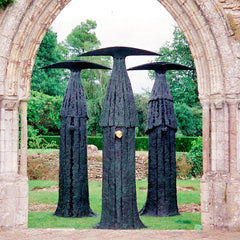To the question 'What is Art?', renowned Russian writer Leo Tolstoy is professed to have answered “Art is a human activity, consisting in this, that one man consciously, by means of certain external signs, hands on to others feelings he has lived through, and that other people are infected by these
feeling and also experience them.”, which suggests that an artist communicates their own experience with the intention of eliciting a similar emotional understanding in the observer.
Aesthetic responses to art have historically been considered basic stimulus responses, but more recent studies, in which celebrated art historian Alexander Nemerov has been involved, suggest that these emotional responses are actually more complex.
It is said that the viewer's experience is influenced by whether or not they 'like' or 'dislike' the piece, placing them somewhere along a spectrum from 'pleasure' to 'repulsion'. Whether or not they like a piece is firstly determined by their own understanding of it; confusion around what they are looking at, if not remedied, can lead to disinterest, then dislike.
Experimental evidence showed that when a piece of artwork was accompanied by a descriptive title, a poem, or artist's statement, the observer had a greater comprehension of the artwork, which resulted in their enjoyment being greater also.
A great example of this in action is Chris Ross Williamson's series of prints, which are each accompanied with a poem, told from the point of view of one of the featured characters. The technique adds another level of interaction, inviting and guiding the observer into his wonderfully humorous world and along with him on his many and varied journeys.
One of Chris's most recent limited edition prints, The Mondrian, depicts a man and his dog admiring a famous painting on a gallery wall, and is paired with the poem:
The poem not only warmly welcomes the viewer into the character's experience, but also sheds light on the meaning of a renowned Abstract artwork, providing the observer with the positive experience of interest, learning, and understanding, thus making the piece hard not to like.
Conversely, confusion can also be used as a tool within art, indeed as a way of encouraging further analysis and exploration of the piece. Contemporary artist Ilse Michielsen creates bold mixed media paintings, and the piece Be Yourself – Remembered at first seems totally abstract, the meaning ambiguous. Yet on further inspection, vague silhouettes and hazy faces start to emerge to
expose the artist's directive.
Within and around these basic responses, there is purported to be a much more diverse range of emotions felt when experiencing art.
Surprise is another device which can be employed by the artist in an attempt to elicit interest from the observer. When we are surprised by something, the amygdala (our brain's fear centre) is aroused and prompts us to become focused solely on that which has startled us because of a perceived possibility of danger. This single focus leads to exploration, then interest, then understanding of the piece.
An observer's understanding, and therefore reaction, can be determined by their own experiences.
Because artwork conveys the specific narrative of the artist, some people may experience negative emotions like anger, frustration, or contempt, because the observer and artist sharing differing experiences can cause confusion over the message, or wholehearted disagreement, and even outrage.
So proficient in the ability to elicit and convey emotions is art that the discipline of Art Therapy can be used to help treat psychological disorders. It wasn't until the 1940s that the treatment was formally recognised after doctors noticed individuals who were living with mental illness often felt more at ease expressing themselves through painting and drawing.
Now, the technique involves both the creation and appreciation of art in a variety of forms to help explore difficult emotions, develop coping strategies for stress and anxiety, to boost self-confidence, increase social skills, and develop self-awareness to name just a few.
Self-taught British artist Rosa Sepple began to paint following a period of depression, and says “my paintings are an expression of a playful world I never had (...) I can take my most excessive imaginings for a walk in complete safety and do all the naughty things I might like to have done.”
A sensitive soul and an eternal optimist, popular Brighton artist Sam Toft faces the challenges that life has presented her with an open heart and a sense humour which comes through in her paintings. She has found her journey into art to be an incredibly healing one, and this is something which she means to portray in her work. “[my work] is so quintessentially 'me' (...) I put so much love and enthusiasm into my work, perhaps that’s what makes it so relatable (...) I think people see themselves in Mr Mustard as I do too.”
Continuing themes of loss, loneliness, and relationship difficulties are depicted in her artwork with an unconstrained sense of fun, thereby promoting feelings of hope to overshadow the heartache.
This is particularly well presented in the piece Tomorrow is Another Day, which poignantly portrays a man and his dog stood on a lonely hilltop sharing a comforting embrace.
In 2016 the Journal of the American Art Therapy Association published a study citing that less than an hour of creative stimulation could reduce stress levels and have a positive effect on mental wellbeing. And further, a study published in 2017 found that when art was displayed in hospital settings it helped contribute to an environment where patients felt safe.
As well as the subject, texture, colour, and tone all have a part to play in influencing an emotional response in the viewer. Generally, darker compositions with shadowy elements or figures generate negative connotations such as feelings of oppression, sadness, or agitation. Bright and light paintings featuring open spaces often conjure feelings of contentment, relaxation, or excitement.
The power of colour, and groups of colours, is capable of commanding very specific responses in observers. You have probably noticed that most posters for horror films will use black or dark blue compositions punctuated with red, as it sparks fear, and conveys danger. More about this subject will be covered in next week's article The Power of Colour.
Artists can use scale to bring about a reaction. Philip Jackson, a renowned sculptor with an outstanding international reputation, creates monumental pieces which tower over the observer and provoke feelings of wonder and awe. The experience of the sublime is said to produce psychological arousal, and is often connected to the feeling of happiness in response to art.
Interestingly though, researchers have also shown that more sublime feelings are felt when looking at artwork after feelings of fear have been induced. This could go some way to explaining why admiring his globally extolled work can be so awe-inspiring. Standing at more than 3 meters high, The Sentinels strike an imposing figure which could initially arouse the fear brain. On further examination, the meticulous posturing, skilled sculpting, and grand beauty of the piece could elicit amazement and heightened sublime feelings.
If you would like to experience and experiment with the effect that art can have on emotions, head over to our online gallery to browse through our vast collections of wall art and sculptural pieces.
You will find a variety of artistic styles, in subject areas including wondrous wildlife, dramatic landscapes, whimsical narrative art, vibrant cityscapes, colourful seascapes, majestic equestrian art, powerful abstract art, and quirky domestic animals.
If any of the pieces elicit an emotional response, you can even place an order online, or give us a call in our office.








